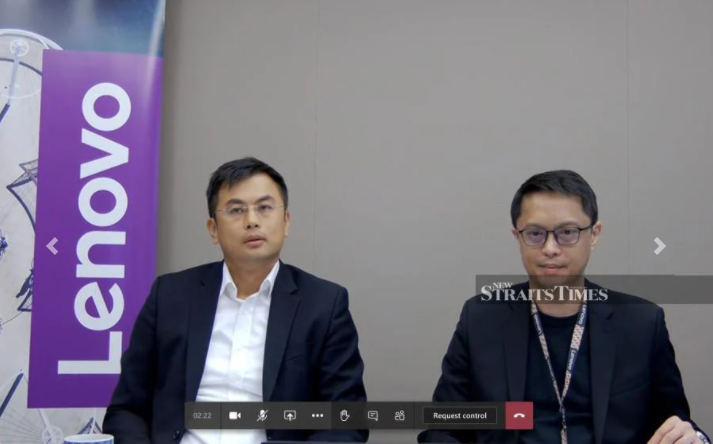#TECH: Lenovo bullish about services market
THE current Covid-19 pandemic may have put many tech businesses in the red, but PC maker Lenovo is still bullish about its business prospect in Malaysia as well as in the Asia Pacific region.
Its Asia Pacific president Ken Wong said the whole pandemic has completely changed the businesses and communities in the region.
“We see growth across all our key business units, with 26 percent market share in the PC business,” he said.
Lenovo’s latest financial results reveal that the Group’s revenue is up by 7 percent year-on-year to US$14.5 billion, with a second quarter pre-tax income of US$470 million, up 52 percent year-on-year.
The company’s net income rose 53 percent year-on-year to US$310 million.
“The Group sees significant future growth opportunities well exceeding analyst forecasts,” said Wong during the Lenovo Tech World ’20 press event recently.
“For Malaysia, the commercial market has been slowing down for the past few months. The corporate companies are more conservative in spending, but starting from last month the consumer market is growing. Last year the consumer market in Malaysia grew by 40 percent year on year, and on top of that we are also seeing a lot of demand coming from the education market,” said Lenovo Central Asia Pacific general manager, Ivan Cheung.
New growth
One of the interesting progress this year is that Lenovo has launched its first gaming phone under the Legion brand, and also the first 5G foldable phone in Asia.
Besides that Wong said Lenovo’s Data Centre business, which include server, networking and storage offerings, continues to grow faster than the market, despite the challenges happening to the businesses around the region.
“One of the key focuses of our business today is the services segment where we had a record high service revenue in the last quarter and some very strong growth across all the services that we offer in Asia Pacific,” he said.
Despite being known as a PC company, Wong said Lenovo has been putting a lot of focus on its services business in the last 24 to 36 months.
“This is because we see the world is changing. Technology is so important to everyone and our customers are getting more demanding on how we leverage technology to help them to overcome the challenges and capture the opportunity around them,” he said, adding that the Covid-19 pandemic is actually a catalyst to all these growing demands.
“We are ‘future ready flexibility’ with our whole offerings regardless of service offerings built hardware, software, and services are built around our customers,” he said.
Among the services business offered by Lenovo currently include after-sales support which include premier support, managed services which could help the CIOs to help them from their day-to-day operations so that they focus on key business strategy, and across these services the company also introduced “as-a-service” business model and this is available across its technologies, be it hardware, software and services.
“This will give companies flexibility in terms of agility for their business,” he said.
Then, Wong said, there is a service involving the deployment of a complex IT system, like finance, enterprise resource planning, etc.
“For example, in a PC deployment of a company, Lenovo ‘as a service’ model provides by seat arrangement which can be subscribed on a monthly basis and it comes with all the services, such as help desk support, security patch, etc, and we package all in ‘as a service’ model and clients only need to tell how many seats or PCs they need in a monthly basis,” he explained.
“This way companies do not have to think about what would the demand for PCs would be monthly,” he said.
Opportunity in food services
When the pandemic started, one of the biggest challenges was that restaurants especially in this region have to shut down because of the direction from governments.
“So this created a demand in food delivery services,” said Wong.
“However, food delivery companies’ core competencies are in recruiting the different restaurants that are well established, but the problem is how can we cater to the smaller restaurants and food stalls around the city for instance?,” he said, adding that there are thousands of these small food outlets in Hong Kong for example.
“And you need to make sure they connect to the food delivery platform which involves the usage of tablets, and help the users use the system and a call centre to help them,” he said.
Wong said all these are not the core competence of a food delivery company, and this is the pain point.
“So with our existing support business, we just extend our support to these food delivery companies so that they can focus on their core business in recruiting and managing the restaurants,” he said.
“This has resulted in people being able to enjoy good food, even though the restaurants are closed, and these restaurants can also continue to service amidst the pandemic,” he added.
For restaurants, Lenovo recommended an onboarding start-up kit for new restaurant partners who had signed up with the food delivery services platform.
Lenovo’s solution encompassed tablet devices that were pre-installed with the food delivery app, containing all the information necessary to help eatery operators set up and operate on the platform in a self-service way.
“The easy-to-use, intuitive resource made for a quick onboarding solution for restaurant partners to urgently digitalise their operations and continue serving customers despite declining footfalls in their physical eatery venues,” said Wong.
Besides that, Lenovo’s solution extended beyond food delivery. With the tablets, restaurant partners are also able to provide a self-service option with which customers who were dining-in could browse their menu and promotions digitally.
“This convenience freed up restaurant staff to focus on responding to the needs of other customers and upkeep high quality service stands within their eateries,” said Wong.
Source: NST

